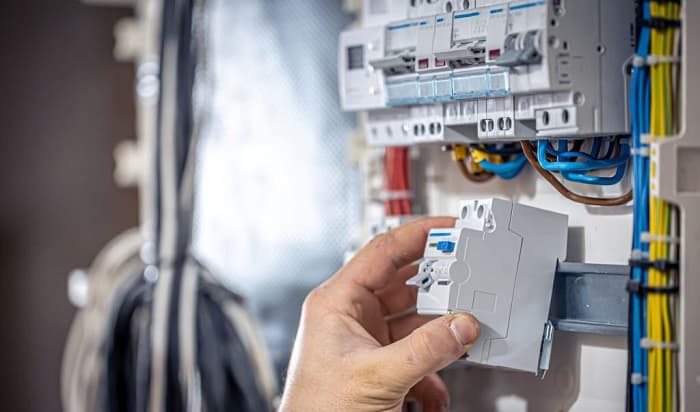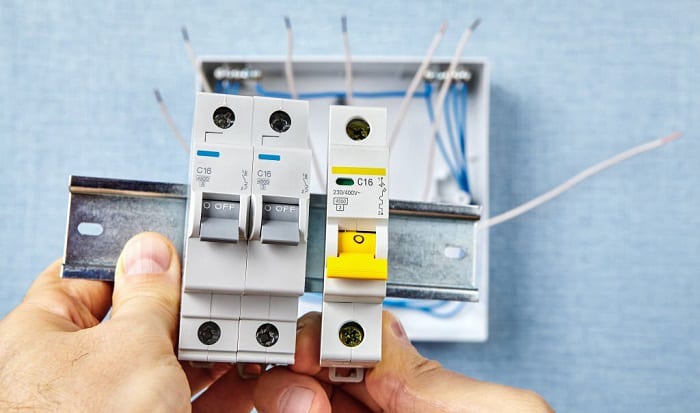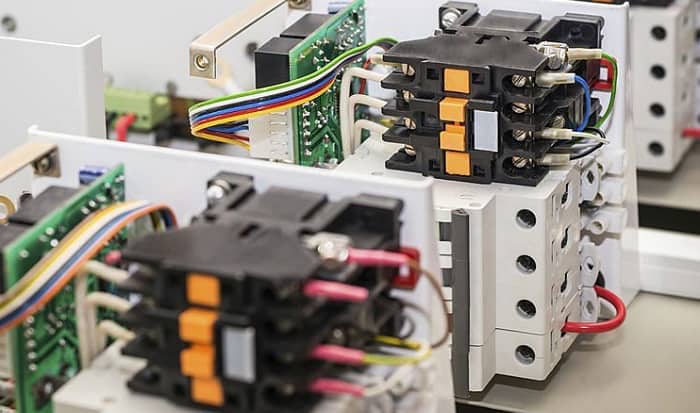If you’re planning to upgrade your old breaker panel or install a new electrical system, it is good to consider MCB circuit breakers. In terms of fault detection, they deliver a very effective response. They are also the latest model of circuit breakers equipped with some advanced features.
Interesting, right? Continue to read this article in its entirety to obtain more knowledge on what is a miniature circuit breaker.
Table of Contents
MCB Definition and Meaning
The MCB (also known as the “Miniature Circuit Breaker”) is an electromagnetic switching device that is made from insulating materials. Like a typical plug-in circuit breaker, the MCB circuit breaker can manually switch on and off.
A miniature circuit breaker is a small trip switch that provides overcurrent protection. This overcurrent is an electrical fault that is caused by short circuits and overloads. MCBs are mainly used to protect electrical appliances in residential, commercial, and industrial electrical systems.
Unlike fuses that are mostly found in some older houses, a mini circuit breaker has many advanced features. One of these is its highly reusable function after damaging electrical faults occur in your electrical system.
Another advantage to MCB circuit breakers is that they have two sensing elements inside. There are thermal and magnetic elements that recognize different electrical faults. Some explanations below will give you an understanding of how an MCB works.
How Does a Miniature Circuit Breaker Work?
What does a miniature circuit breaker do to protect the electrical system from electrical faults?
When it senses an excess current, an electric MCB mechanism reacts with speed. It turns into a trip position in less than three milliseconds.
This ability stems from the two sensing elements inside. For a better explanation of each sensing element, here are their functions in two different scenarios.
1. Magnetic Function
In the event of a short circuit, the flowing current ratings can go up about 10 to 100 times the average current.
When this happens, a strong magnetic field is created. Since the magnetic field is strong enough, it can be sensed by the magnetic elements, and they immediately trip the breaker.
Moreover, during short circuits, there can be a dangerous arc. This arc is very harmful since it can flow into the air. In this instance, a component called an arc runner, or arc chute inside the MCB serves its purpose of preventing this hazardous leakage.
The arc runner is made of a parallel plate set that absorbs the hazardous arc and kills it, so it can’t damage anything outside the circuit.
2. Thermal Function
An overload is caused by extensive electricity use in a single circuit. A common example of circuit overload is when too many appliances are powered by and connected to an extension cord.
At the time of circuit overload, the excess current ratings are 2 to 5 times the normal operating current. This excess current is not as high as short circuits, which is why the magnetic component cannot detect it.
That said, this fault can still cause damage. During circuit overloads, the bimetallic strip inside the MCB senses the sudden thermal rise and causes the circuit breaker to trip.
This video by Lesics might give you more information on the function of MCB devices. It also shows viewers how the normal MCB circuit breaker reacts to excess currents.
Types of Miniature Circuit Breaker
Currently, there are many MCB-type breakers available on the market. However, the three major versions of MCB breakers are the B, C, and D. Each of these different MCBs has different specifications. You can see them below.
1. Type B MCBs
Type B MCB breakers instantly trip when the current flows reach three to five times the normal rated current. You will see this type in low-voltage lighting circuits and IT systems.
2. Type C MCBs
Type C MCB breakers quickly trip when the flowing current reaches five to ten times its normal current. They are used for inductive loads and setups with slightly high startup surges.
3. Type D MCBs
Compared to other MCB circuit breakers, the type D MCB is the least sensitive when it comes to trippings. It only reacts when the current flow reaches ten to twenty times the normal current. Like other kinds of MCBs, type D doesn’t protect against earth faults.
How Much Is the Cost of Replacing an MCB Switch?
The average cost of replacing a circuit breaker is $1,475. However, the price may vary depending on the brand, rating, and the MCB circuit breaker type. That is why it is good to refer to your preferred brand of MCB for its own price guide.
Furthermore, you also need to be specific regarding the MCB rating to ensure the device can handle the load of your circuit.
Plus, you also need to be careful about MCB circuit installation. Looking for an MCB wiring diagram or the polarity label at the side or the back of your MCB circuit breaker is advised. If the device’s polarity is not adhered to, malfunction can occur.
Conclusion
Knowing what is a miniature circuit breaker may help you decide whether it is good for your electrical system.
Does this article effectively explain what an MCB circuit breaker is? Do you think it’s advantageous to install such a device? Let us know your thoughts in the comment section below.
Related:
- The best explanation about Molded Case Circuit Breaker
- Tandem Circuit Breaker? – A Simple Explanation

I am Andrew Wright. With 8 years of experience designing, installing, and maintaining electrical power systems. I love my job, and I have always wanted to offer others the necessary help so they can take care of their houses.



